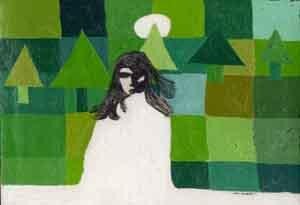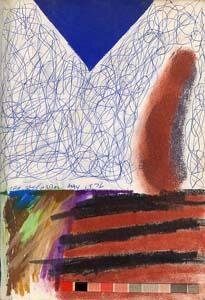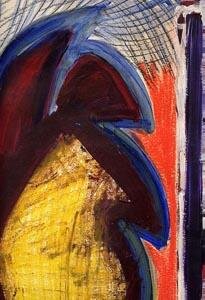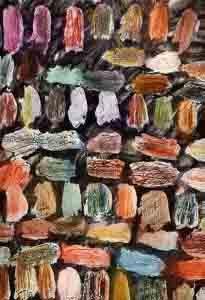Meet the Mentor | Ira Joel Haber
Graphic by Andy Zeng. The above photo is a painting of Ira Joel Haber (left) done by a colleague, Sylvia Sleigh, courtesy of Google Images.
The COUNTERCLOCK Arts Collective is an online, 8-week fellowship program that allows creative writers, visual artists, and musicians to explore, illuminate, and grow through collaborating on interdisciplinary projects. Learn more about the Arts Collective here. For the next weeks leading up to the application deadline, we will be featuring mini-interviews with 2020 mentors.
About the Mentor
Ira Joel Haber was born and lives in Brooklyn. He is a sculptor, painter, writer, book dealer, photographer and teacher. His work has been seen in numerous group shows both in the USA and Europe and he has had 9 one man shows including several retrospectives of his sculpture. His work is in the collections of The Whitney Museum Of American Art, New York University, The Guggenheim Museum, The Hirshhorn Museum,The Albright-Knox Art Gallery & The Allen Memorial Art Museum. Since 2006 His paintings, drawings, photographs and collages have been published in over 230 on line and print magazines. He has received three National Endowment for the Arts Fellowships, two Creative Artists Public Service Grant (CAPS) two Pollock-Krasner grants, two Adolph Gottlieb Foundation grants and, in 2010, he received a grant from Artists' Fellowship Inc. in 2017 & 2018 he received the Brooklyn Arts Council SU-CASA artist-in-residence grant.
CAC: Could you briefly introduce yourself and your discipline? Why did you choose this discipline?
IJH: Making art, including sculptures, painting, drawing and photography. I also write, reviews art reviews and movie reviews.
Nature frightens. No slow early autumn walks in the country for me. Nature is a mother with a knife, ready to pounce on us without warning. Mountains collapse, rivers reclaim, skies open up and caves swallow. But there is also a beauty in this destruction. Keeping myself far away from all things that are natural is what I have a sweet tooth for. The landscapes of my mind reach out for other minds in beautiful acts of aggression.
CAC: Why do you make art? When did you realize it was something you wanted to pursue?
IJH:: I have always wanted to be an artist. I was born to be an artist and have been doing it all my life. Nature frightens. No slow early autumn walks in the country for me. Nature is a mother with a knife, ready to pounce on us without warning. Mountains collapse, rivers reclaim, skies open up and caves swallow. But there is also a beauty in this destruction. Keeping myself far away from all things that are natural is what I have a sweet tooth for. The landscapes of my mind reach out for other minds in beautiful acts of aggression.
I would like to begin my narrative here in the near past, and then tell about my art career. In 2001 after living in my loft for 31 years, I was forced to move because my landlord out of pure and simple greed, wanted to get more rent than I was paying. I cannot begin to tell you what an awful experience this was. I had to move 31 years of my art into storage, and I had to leave Manhattan and move to Brooklyn where I have a 2 bedroom apartment. This is a small apartment, and I am using one of the bedrooms as a studio space. It was hard at first but I soon got back to my personal and creative life and slowly I started to make art again. I began to make sculptures along with large collages. The shock of losing my studio was extreme, but I was pleased that I started to make art again, and I realized that no matter what I will never stop making art.
Haber’s “Works on Paper” – Cleaver Magazine
CAC: When did you begin your sculptural work that defines much of your later artwork?
IJH: The earliest piece of existing sculpture that I did dates from 1958. I was very young. The piece is made of white interlocking plastic building blocks that always play with. For me it was more than just play. The piece has some similarities to my present concerns. It looks like a building or a structure or a ruin. I glued the individual blocks together. Even at this early stage I was concerned with making a permanent work of art. I found this lost and forgotten piece in 1971 at the home of my parents in a box of old things of mine that my mother had kept for all those years. The piece was broken into four sections, but it was not difficult to repair because the parts fitted together like a puzzle. I remember doing this piece, but it’s a vague memory.
In 1968 I started to fill small black sketchbooks with collages. I thought of them as intimate objects to be looked at by one person at a time. I never ripped out pages. I did these books for about a year when I decided I had accomplished at that time what I wanted to do with collage. In early 1969 I wanted to expand my ideas of collage, to break through the paper and get to the other side. It was at this point that I started my work involving small scale sculpture, miniature environments and landscapes.
My training was in commercial art. I began working in the advertising field in 1966 upon completing a 2 year course at New York City Community College as it was then known. This training was outdated. In any event I had little trouble in finding jobs. However these jobs depended on skills that I really didn't have, and my heart was not really in the ad game. I wanted to be an artist. At night I took drawing and illustration classes at The School Of Visual Arts, which made me want to be an artist more than ever. Finally in 1967 I stopped working in advertising and from that time on I have devoted my life to being an artist.
Growing up in New York gave me easy access to all the museums and at an early age, I started to go to the Brooklyn Museum, the Museum Of Natural History, the MoMA and the Whitney. I was particularly attracted to the large dioramas at the natural history museum, not just for the history they told, but for how they told that history. I was fascinated by the artificial landscapes and how they were made.
CAC: How did your background as a New York resident impact you?
IJH: Growing up in New York gave me easy access to all the museums and at an early age, I started to go to the Brooklyn Museum, the Museum Of Natural History, the MoMA and the Whitney. I was particularly attracted to the large dioramas at the natural history museum, not just for the history they told, but for how they told that history. I was fascinated by the artificial landscapes and how they were made. At the same time, I was also seeing the great works of modern art. The one work that stands out as having an impact on me as a child was Ernst's "Two Children Are Threatened By A Nightingale" which left a lasting impression on me because of Ernst's use of strange perspective, bright almost acidy coloration and the three-dimensional miniaturization of a gate and house. Some other influences were amusement parks, notably Steeplechase Park, movies, Times Square and the artists Joseph Cornell and Louise Nevelson. Knowing their work from an early age was an education. Seeing what they (and others) had done with assemblage was inspiring and made me realize that although their accomplishments were magnificent, there was still room for an original new voice to be heard.
The first box I did was in 1969 and was made of cardboard which was completely covered with a photographic reproduction of a landscape. Inside the box I placed a cardboard backed cut-out photograph of the artist Toulouse-Lautrec as a child surrounded by his family. Unfortunately part of this box was destroyed. This box was not complicated enough for me and my feelings for the figure was not very strong. The first landscape boxes I did were also done in 1969 and were a series of "New York boxes". They were small with diorama backgrounds of the city skyline in the 1900's along with loose material usually gravel or sawdust dyed to represent earth. At the same time I started my pieces involving architecture both in boxes and pieces placed on the floor. My boxes from 1969-1971 usually had neutral landscape photographs as backgrounds. Using these backgrounds allowed me to confuse the perspectives of my landscapes and employ contradictory scale systems both in my boxes and floor pieces. It was also during this period that I actually burned many of the miniature buildings I was using. The interpretations and connotations of this element of my work was usually psychological and secondary to what I was actually doing. Simply put I was altering, changing and manipulating my found materials as modern artists have done since Cubism. The action was just as important to me as the outcome of the work and the reactions the work would invoke. I think nature has a tendency to reproduce itself in miniature. A twig, a small stone or a puddle of water when separated from its natural environment and isolated can resemble a tree, a boulder or a lake. I find it a little difficult to summarize in this short piece all my feelings and ideas about what I have been doing for the last 43 years.
CAC: How do you draw inspiration from nature?
IJH: I want my art to go through slow constant changes, but at the same time I want vast abrupt changes. Nature does the same. Since 1969 I have been making small scale sculptures and miniature environments that have been boxed, floored and walled. Within these small spaces a wide range of images have been constant & consistent. Houses, mountains, trees, bodies of water and land masses. My work over the years has changed, as I'm always experimenting with my language.
In 1970 I showed a piece of mine for the first time in the Whitney Sculpture Annual. Soon after I was asked to join the Fischbach Gallery where I showed from 1971-74. In 1978 I joined the Pam Adler Gallery where I had three shows the last one being in 1982. In the fall of 1991 I was invited to be a guest artist at the 55 Mercer St. Gallery which is a co-op gallery. The exhibition consisted of ten pieces from 1984-1990. This was my last one person exhibition.
Through the years I have been helped by various organizations & foundations that have awarded me grants. Most notable has been the N.E.A. which awarded me grants in 1974, 1977 and 1983. I also received two grants from The Pollock Krasner Foundation in 1986 and 2001 and in 2004 and 2018 I was awarded grants from The Gottlieb Foundation.
CAC: How do you balance your artistic life with your entrepreneurial pursuits?
IJH: Like all artists I would like to spend most of my time & energy making art. However since I began my professional career as an artist in 1969, I've always had to work to make ends meet. For a while I taught at various universities around the country. While this was rewarding in many ways, it was also difficult because of the small salaries paid, and the "gypsy" lifestyle one must adapt to when going from one university to another. Since 1988 I have been my own boss, dealing in out of print film and performing art books. Having my own business has its' pluses & minuses. This is a full time job and I have my books listed on several out of print book sites on the internet, not to mention the finding, buying, cataloging etc. that a serious book dealer must do. However it does not bring in much money. I have also had several small teaching jobs, the longest one was for over 10 years teaching at the UFT a sculpture, assemblage, collage class for retired public school teachers. This job came to an end a few years ago because of low enrollment. The most recent teaching job I had was through BAC and their Su-Casa program which gave me a grant and involved a 5 month teaching workshop for seniors in Brooklyn. Because of my small amount of money I have had to for the last several years take in roommates. I have given up my bedroom and now sleep on a fold up mattress in my living room. Not an easy situation but I have been lucky with the 5 roommates I’ve had so far.
Harber’s “Note Book Drawings 2015” – Boston Accent Lit
CAC: Can you discuss the last project(s) that have meant the most to you?
IJH: From 2006 to 2013, I made a series of small 7” x 7” x 3” boxes using landscape, nature and architectural elements. These themes have occupied my time and interest since 1969. These “new” boxes of which there are ten are small and densely packed and at the same time because of the size are sparse and minimal in their imagery. Also in 2012 I did a series of 10 wall sculptures or plaques each one measures 6 ¾” x 6 ¾” with the overall size variable. They also contain themes and images incorporating elements of nature, landscape and architecture. In 2014 I started a series of “open” somewhat small wall pieces that while incorporating recognizable images like houses and trees also use abstract elements. I have at the age of 67 had to cut down on my art making simply because of the lack of funds to buy art supplies, and a Gottlieb grant would go a long way in helping me to expand my visions. Starting in 2015, I have been making a series of small “open boxes” that I call botanical and they incorporate my recurring themes and images of nature, landscape and architecture in small duplex like spaces.
CAC: What are you currently working on in your artistic life?
A: I am thinking about making a series of boxes that will begin when I begin.




Haber’s “Four Paintings” – Superstition Review
CAC: How do you manipulate medium, style, or voice?
A: I use all kinds of materials, and maybe they manipulate me.
Learn more about the Arts Collective here.
Apply to the Arts Collective here.
Sarah Feng is the editor-in-chief of COUNTERCLOCK Journal and the director of the Arts Collective. Her creative writing has been awarded by the Poetry Society of the United Kingdom, the National Scholastic Art & Writing Awards, the Adroit Prizes in Prose & Poetry, NCTE, the Critical Pass Review, American High School Poets, the Leyla Beban Young Author’s Foundation, Teen Vogue, and the New York Times. She plays piano and dabbles in charcoals, and she thinks rhythm and light and lyric pulse in every field of the creative arts – if you can call them distinct fields at all. In other words, she has faith in the power of the interdisciplinary arts and their persistence in our memories and minds. She studies at Yale University.





